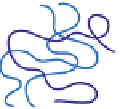Biomedical Engineering Reference
In-Depth Information
n
N
h
2
h
1
R
m
1
m
2
(a)
(b)
Figure 7.9
The two steps involved in the gelation process: (a) formation of a loose network in which a chain
containing N statistical units bridges between two helical sequences (h
1
, h
2
), with n units in coil
conformation and m
1
, m
2
units as free ends; (b) growth of helical sequences, with the collagen rods
entirely renatured at in
nite time. Adapted from Djabourov et al.(
1988a
) with permission from
EDP Sciences.
the kinetics does not suggest a way to discriminate between these two possibilities
(Djabourov et al.,
1988a
).
A microscopic scheme of some of the steps involved in the formation and maturation
of the network of triple helices is shown in
Figure 7.9
.
*
Helices are nucleated along individual chains, supposing, for instance, that the Pro and
Hyp sequences are favourable nucleation sites. The model neglects the fact that there is
a minimum stable helix length, the rate determining cis-proline
flip and the presence of
some covalent cross-links. A triple helix sequence can start to grow when helices are
nucleated on segments belonging to three different chains which are closely entangled.
Concentration and entanglement between chains are factors which enhance the prob-
ability of nucleation of the triple helix, as con
rmed by experimental results and
highlighted by this model.
*
A chain is likely to be involved in several (at least two) of these sequences, creating a
loose network. The
first step of the kinetics can be associated with the rapid process.
If a chain with N statistical units is involved in two junctions separated by a distance R,
as shown schematically in
Figure 7.9
, R can be considered to a
first approximation as
a constant, depending on the local concentration. By simple statistical mechanics, we
can calculate the helix fraction corresponding to this
'
equilibrium
'
con
guration.
The results for these predictions are shown in
Figure 7.10
*
The helix fraction
first step is calculated as a function of temperature. The
statistical unit is taken here as a tripeptide. In this calculation, T
0
= 767 K corresponds
to the binding energy
χ
0
at the
ε
per tripeptide in the helical state de
ned by T
0
=|
ε
|/k
B
. The
(mole) = 6.27 kJ mol
−
1
.
calculated points
fit with a binding energy
ε
*
Note that when the
first step is achieved, the system is not truly in equilibrium. The
second process, which has a logarithmic time dependence, could represent a super-
position of different microscopic times allowing the local constraints to be released
(starting with the cis-proline
final equilibrium
should correspond to the fully renatured collagen rod, where the solution becomes a
suspension of independent rods. This
flip outlined above). In this model, the
final state is not reached within the longest
observation time, and the solution remains a gel with a connected network. In the
nal








Search WWH ::

Custom Search